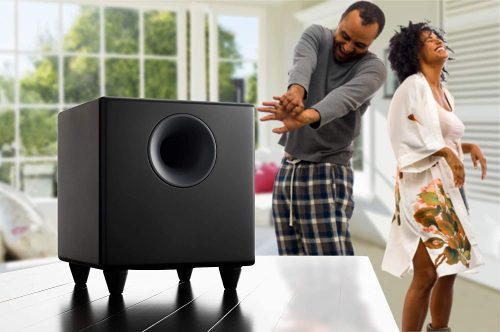
Do you want to enjoy the bass sound from your sound systems? To do this, harmonize a subwoofer, speakers, and amplifier. However, you should pay extra attention to the connections between passive speakers and powered subs to prevent ending up with muffled sounds.
Our sound engineers did the legwork to provide you the methods to seamlessly connect a powered subwoofer to passive speakers.
What are Powered Subwoofers?
A subwoofer speaker is designed to boost low-frequency sounds. It comes with two types: active and passive. A powered one is also called an active subwoofer, while a non-powered one is called a passive subwoofer.
Unlike a non-powered subwoofer, powered subwoofers act as a speaker and an amplifier. The speaker and amplifier of active subwoofers are matched and calibrated to work together to provide the best performance.
Because the speaker and amp are both in just one enclosure in an active sub, this removes the power load off of the receiver. As a result, it powers the mid-range and high-range drivers.

A passive subwoofer needs an external amplifier, but the other has built-in amplifiers already in the unit. It also has a crossover and needs to be connected to a power outlet. Paired RCA connectors are usually used to connect the passive subwoofers to the receiver.
A passive sub need not have its own power supply. This audio equipment is less known than the other type.
Active vs Passive Speakers: Important Differences
Speakers come in two types: active and passive speakers. The majority of speakers used in home theater sound systems are active speakers. This type has an amplifier already within the speaker. Active speakers are known as powered speakers with subwoofers in a 2+1 design setup. It includes two speakers and a subwoofer.
On the other hand, passive speakers use an external amp as a power source. It is connected to it through a speaker wire, usually in the form of an RCA cable. Professional DJs usually use this type as they have more control in the amp and subwoofer output.

Ways to Connect a Powered Subwoofer to Passive
You don’t need a professional to connect powered subwoofers to a passive speaker. Our sound experts outlined the best practices on how to connect a powered subwoofer to passive speakers so you won’t have to pay for professional fee anymore.
Method #1: RCA Connectors
According to our sound engineers, this method is the easiest and most effortless way on how to connect a powered subwoofer to the speaker. A stereo RCA cable connects the two devices. The connection can carry both audio and video signals.
Since they carry both signals, RCA cables usually come in pairs, allowing them to carry stereo signals. Remember, unless the speakers are connected to a power amplifier, they will not produce audio. So remember to make the connection between the two.
The first thing to do is to ensure there is an “OUT” on the speaker and “Line In” on the subwoofer. If the sub has a y-type cable or a split type one, hook the cable to the R and L ports.

Some powered subwoofers also have spring clips on the back as normal speakers have. If it has this, then connect the speaker wire to the receiver’s subwoofer output. The method is also the method used in a basic stereo speaker.
If it only has one set of spring clips, you can use banana clips to plug it into the speaker’s ports.
Method #2: LFE
Low-frequency effects (LFE) are specifically designed to reproduce bass tones accurately. It is usually seen as “Sub Out” or “LFE output” in the speaker. Making connections allows the subwoofer output connector on the receiver to be connected to the “Line In” port.
Most speakers have low-frequency effects. . Here, the 5.1 channel can be used in connecting to the speakers.
Method #3: XLR Cables
Check if both the passive speaker and the powered subwoofer support jack cables. The only difference here is that you need to use XLR cables or 3.5mm jacks. These connecting cables are known to be superior to stereo RCA cables.

However, for this to work, our experts remind us that both devices should accommodate XLR cables. So, it is best to check the compatibility first before purchasing an XLR cable. If you have a very old device, then XLR [1] ports might not be available. Hence, this connection will not be possible.
Why Connect a Powered Sub to Passive Speakers?
Connecting powered subwoofers to passive speakers will unlock your speaker’s potential for a high-level amplified bass sound. After learning how to connect your powered subwoofer, you can now easily route an extra amplifier to your speakers.
There is a big difference in using active subwoofers. Passive speakers can only give you enough speaker volume. In connecting active subwoofers to passive speakers, you will be able to enjoy rocking audio in high speaker-level volumes. Powered subwoofers will drive your speakers to produce louder sounds.

The speakers can amplify mid-range and high-range audio tones that will not be reproduced when using plain subwoofers.
However, cables can be confusing sometimes. So if in case you have issues connecting the two systems, feel free to ask for help from a professional.
Conclusion
If you want to enjoy superior audio using your sound system, then connecting your powered subwoofers to your passive speakers can be the key. Our experts summarized tried and tested methods on how to connect a powered subwoofer to passive speakers. It includes using RCA wires, XLR, and LFE. May you find this helpful for your home theater system setup.
The post How to Connect a Powered Subwoofer to Passive Speakers? — Your Quick Guide appeared first on The Product Analyst.
from The Product Analyst https://theproductanalyst.com/how-to-connect-a-powered-subwoofer-to-passive-speakers/
No comments:
Post a Comment